Average sizes and life expectancy for this breed:
Known for their white coats and lemon or orange markings, Clumber Spaniels are the largest member of the spaniel family. These are very unique dogs with thoughtful, endearing expressions and a relaxed, gentleman-like disposition.
They are thought to have originated in France more than 200 years ago before they were imported into England. The name ‘Clumber Spaniel’ is believed to refer to Clumber Park in Nottinghamshire where these dogs were bred extensively. These gentle dogs were initially developed to find and retrieve game birds for hunters. Nowadays, Clumber Spaniels are still exceptional gundogs, and many compete in field trials. Because of this trait, these dogs adore being outside and will follow a scent relentlessly!
These affectionate and sweet-natured dogs thrive in human companionship. In fact, they love to be involved in everything that goes on in the home. However, they can be wary around strangers. Clumber Spaniels are playful, dignified, mischievous, intelligent, and sometimes stubborn! With the right training, these dogs can make incredibly attentive, lovable canine companions for any family.
See available puppies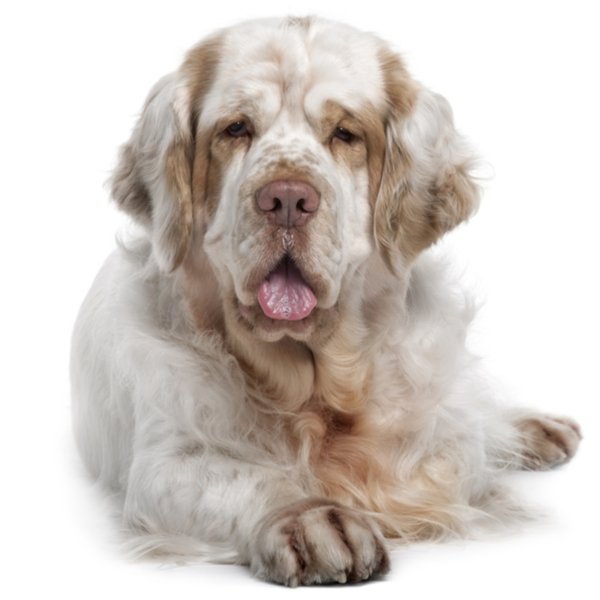

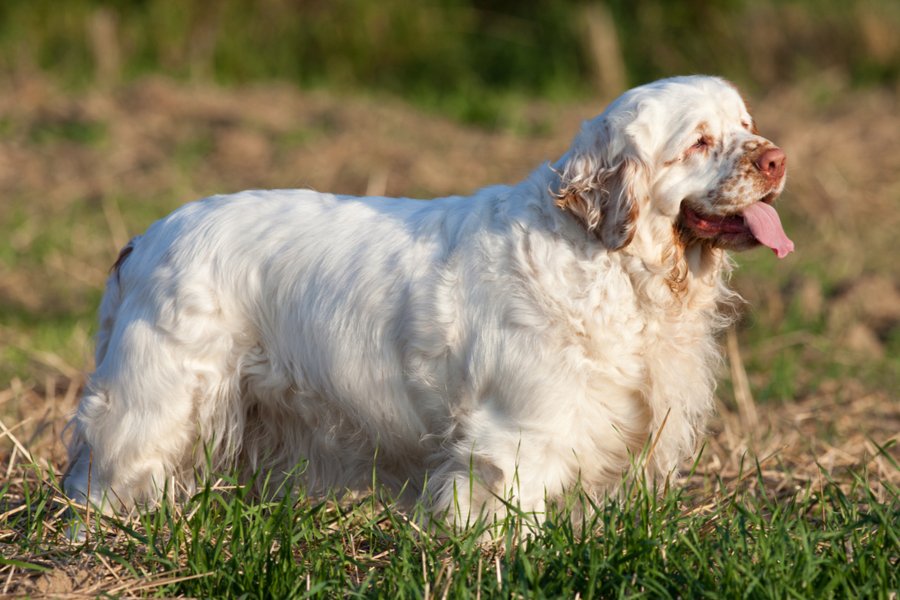


The Clumber Spaniel is considered to be one of the oldest spaniel breeds. They were first bred by a French aristocrat who then exported several of his dogs to England during the Revolution. It was the Duke of Newcastle who then began breeding these dogs on his Clumber Park Estate. In 1768, the second Duke inherited the estate. However, it was his gamekeeper, William Mansell who is credited for developing the sturdy, agile Clumber Spaniel we know today. As a result, they were referred to as ‘the Duke’s breed’ or ‘Mansell’s breed’ for years.
These dogs quickly became favoured by gamebird hunters from wealthy and titled families all over the UK. In fact, these dogs were even popular with a number of Royal family members including George V, Prince Albert, and Edward VII.
The breed has changed little over the years. However, depictions in the late 1700s appeared to be of dogs with smaller heads. In 1834, a painting of Lord Middleton and his Clumber Spaniels showed dogs that looked much more similar to the Clumber Spaniels of today.
The world wars and the increase in industrialisation led to the closure of many sporting estates. However, the breed still managed to survive thanks to a few dedicated breeders. In 1954, Rae Furness brought a female Clumber Spaniel from Brian Gent. She then bred the dog with her own famous Irish Setters. This is believed to be one of the biggest influences on the modern-day Clumber Spaniel.
Clumber Spaniels arrived in America in the late 1800s and became one of the nine charter breeds of the American Kennel Club (AKC). In 1972, the American Clumber Spaniel Club was formed. The British Clumber Spaniel Club was founded in 1904.
Today, Clumber Spaniels remain a rare but beloved breed amongst families, hunters, and in show rings.
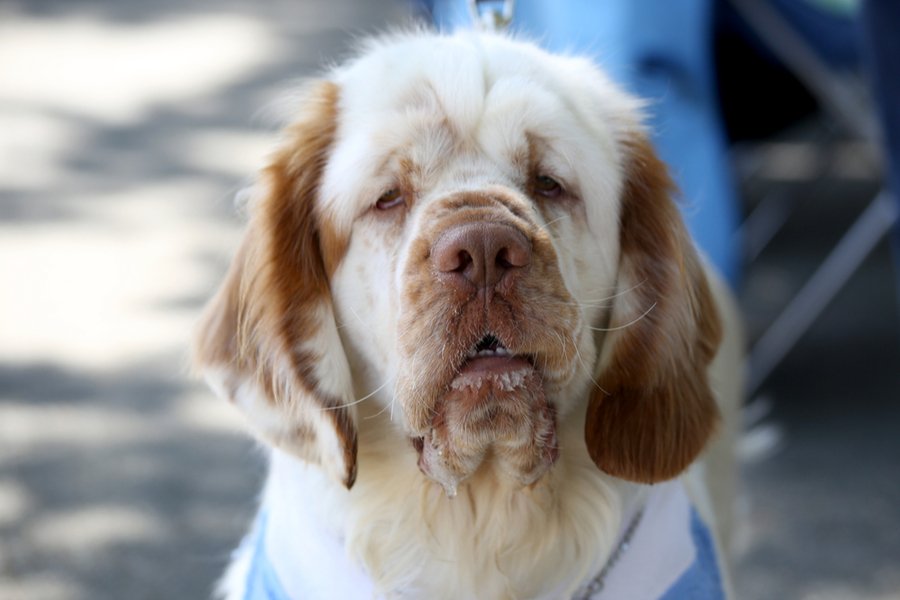
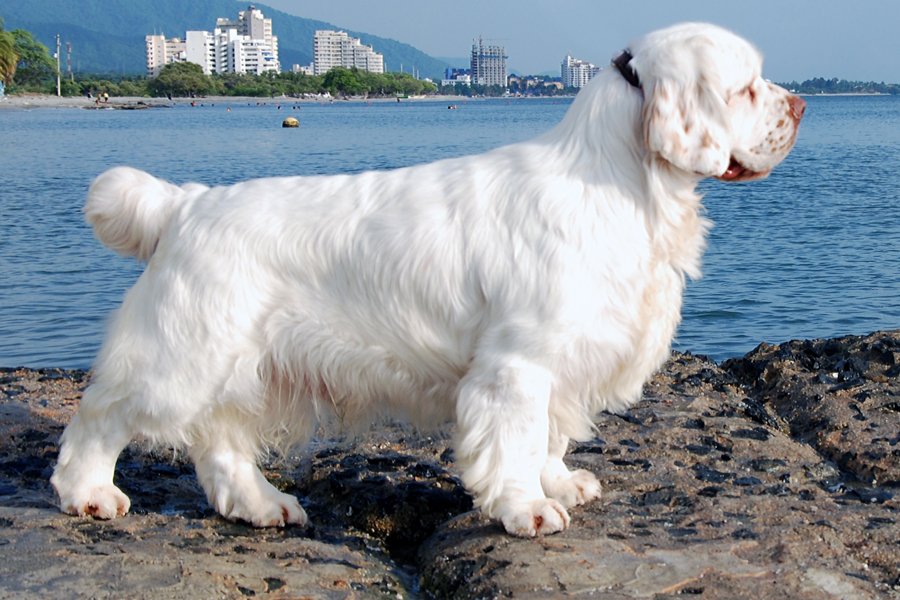
Clumber Spaniels are significantly heavier than their other spaniel cousins. They are well-boned, active dogs with an appearance of strength. These dogs have large, broad heads with square muzzles and well-developed upper lips.
Clumber Spaniels have heavy brows and amber or dark eyes that are full of expression. Their leaf-shaped ears are large and well-covered in hair. They hang forward and are slightly feathered. These dogs have long, powerful necks and sloping well-muscled shoulders. Their front legs are straight and well-boned.
The body is long, strong and well-muscled with well-sprung ribs, and a deep chest. Their loins are muscular and well let down on their flanks. They have well-developed and strong hindquarters with powerful back legs. Their round feet are large and covered in hair. Their tails are extremely well-feathered, set low, and carried level to their backs. The tails were previously docked so a shorter tail is still acceptable under the breed standard.
The Clumber Spaniel is coated in silky, straight hair that lies close to the body. Both the legs and chests are well-feathered. These dogs come in two-tone colour types such as lemon and white, orange and white, white and lemon, and white and orange. According to the UK breed standard, a white body is preferred, with lemon markings. Although orange markings are acceptable.
Some dogs may have a few markings on their heads and freckles on their muzzles which adds to their endearing appeal.
Clumber Spaniels are an ideal choice for novice dog owners because they are intelligent, gentle, and affectionate. They are known for being very good around children, as well as other pets. However, bear in mind that these are large, muscular dogs so all interactions need to be supervised for safety purposes.
These dogs form strong bonds with their families and are highly eager to please. As a result, they do not do well when left alone for long periods because this can cause them to develop separation anxiety. So, they are best suited to homes where someone is around for most of the day.
Clumber Spaniels are easy-going but they also have a strong instinct to work. This can often be seen when out on walks. These dogs love to dive into bushes to investigate a new scent! Clumber Spaniels have a somewhat independent nature and a boisterous and mischievous streak, especially as puppies. However, with regular training and care, these dogs will grow up into gentle, well-mannered, yet playful adults. One of the most endearing traits of the breed is their desire to carry around a toy or other favourite item. This is thought to stem from their retriever background.
It’s worth noting that these dogs are known for their snoring habits and their tendency to “slobber”, especially when excited. Compared to other spaniels, Clumber Spaniels tend to be wary of strangers. However, they rarely show any signs of aggression. They will remain aloof and standoffish until they are comfortable enough to engage.
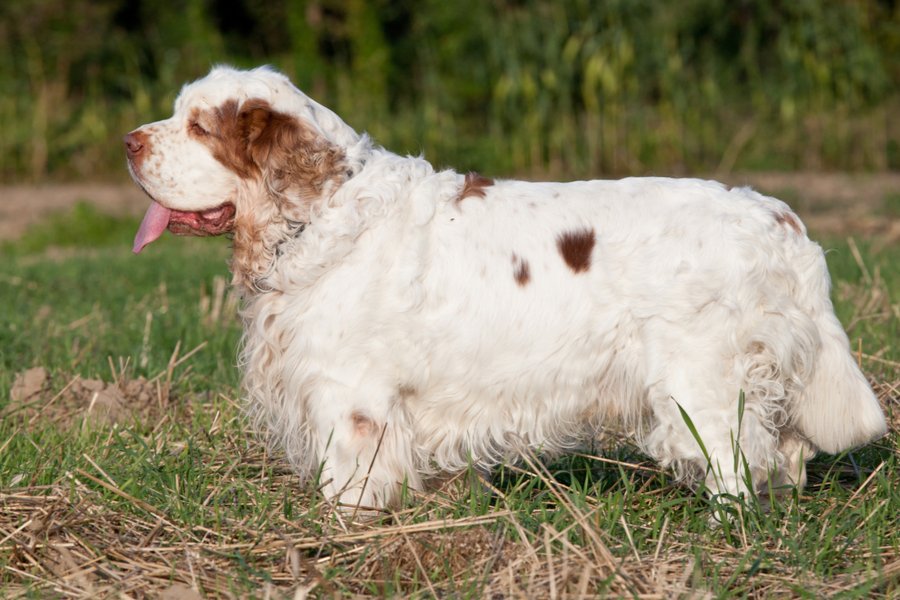
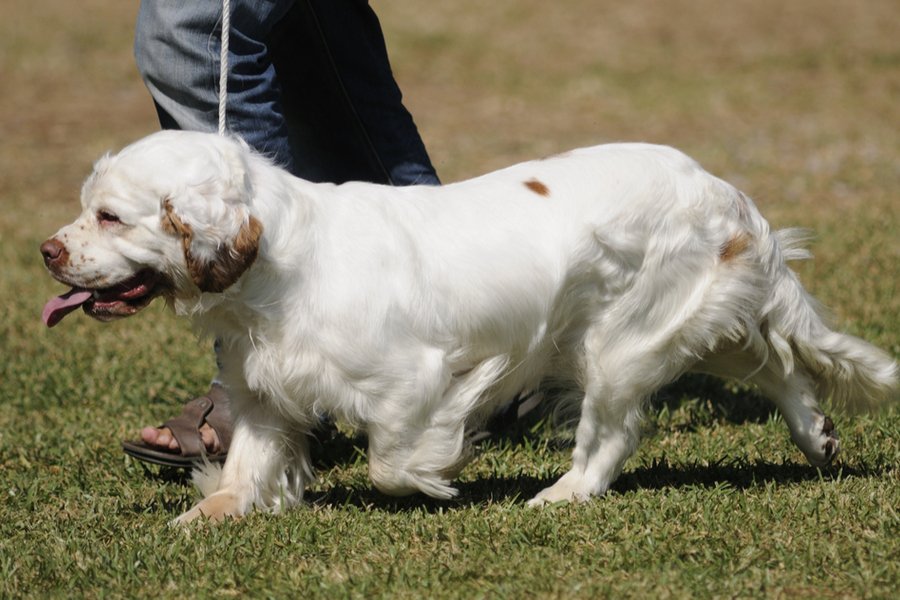
Clumber Spaniels are highly intelligent and eager to please, making them easy to train. Recently, Clumber Spaniels have even been trained as tracking dogs and many excel at agility courses.
Clumber Spaniels are also often trained under the PAT Dog scheme, tasking them to visit people in hospitals, as well as residents of nursing and retirement homes, because of their kind natures.
Training should start as soon as you bring your puppy home and remember that respect training is more important than obedience training. These dogs are sensitive so don’t respond well to harsh training methods. They can also be a bit stubborn at times. However, as a working gundog breed, you can use their natural work ethic to your advantage by incorporating scent games and puzzles into your everyday training sessions.
Clumber Spaniels are heavy shedders and it happens throughout the year. So, it’s essential that you groom your puppy at least three times a week, paying close attention to the feathering on the legs and paws. This is especially important after a trip outdoors because these areas are prone to picking up debris and matting. It’s also a good idea to regularly trim the hair around their feet to prevent any knots from developing between the toes.
Clumber Spaniels should be bathed once every two weeks or so, combined with regular visits to the grooming parlour to ensure their coat and skin remain in good condition.
Keep a close eye on their ears, especially after a walk outdoors. They need to be dried thoroughly because a build-up of moisture can lead to a yeast infection. These are notoriously difficult to treat. To clean their ears, use a clean cotton ball or cloth with a vet-approved ear cleaner. Remember not to push anything into the ears to prevent damaging the ear canal.
Nails should be trimmed and cleaned frequently because long nails can be very painful for your pup. Additionally, as you trim and clean their nails, make sure to check their paw pads for any cuts, scratches, or swollen areas.
Brushing their teeth every day is still the best way to prevent tooth and gum disease and bad breath. However, brushing 2-3 times a week is more than adequate to dodge any bacteria or tartar buildup.
Lastly, make sure to check their whole body over during grooming sessions for any signs of pain, discomfort, swelling, or infection. You should also regularly check their eyes; they should be clean, clear, and free of discharge or crustiness. Remember that these dogs are prone to drooling so make sure you keep their mouths and chests dry to prevent skin irritation.
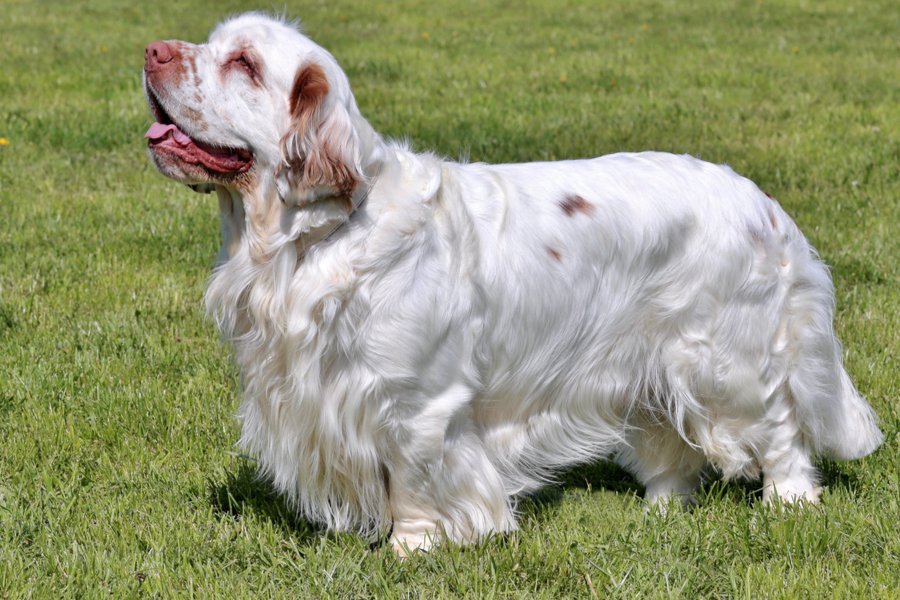
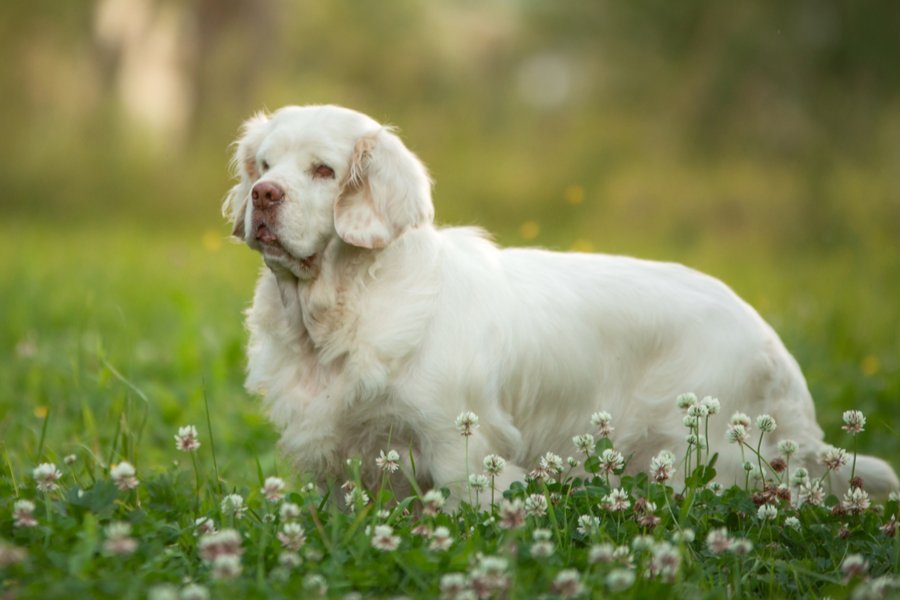
Like other breeds, Clumber Spaniels are known to suffer from certain health conditions. So, it's vital that you only buy puppies from a licensed and reputable breeder. Not only will this ensure that your puppy has been well cared for, but they will also be able to perform DNA checks to determine if any underlying health issues are present.
Some of the health concerns that affect Clumber Spaniels include:
Clumber Spaniels make a good choice for families with children as they are extremely tolerant and gentle. These dogs have laid-back, easy-going natures and they adore being part of a family. However, adult supervision is still recommended as these affectionate dogs can be a little boisterous and excitable sometimes, especially when they are puppies.
These dogs are also great around other pets and animals as long as they have been introduced with care. Remember that Clumber Spaniels are wary around strangers, which includes unfamiliar animals. They are also not best suited to homes with other smaller pets as these dogs have a high prey drive.
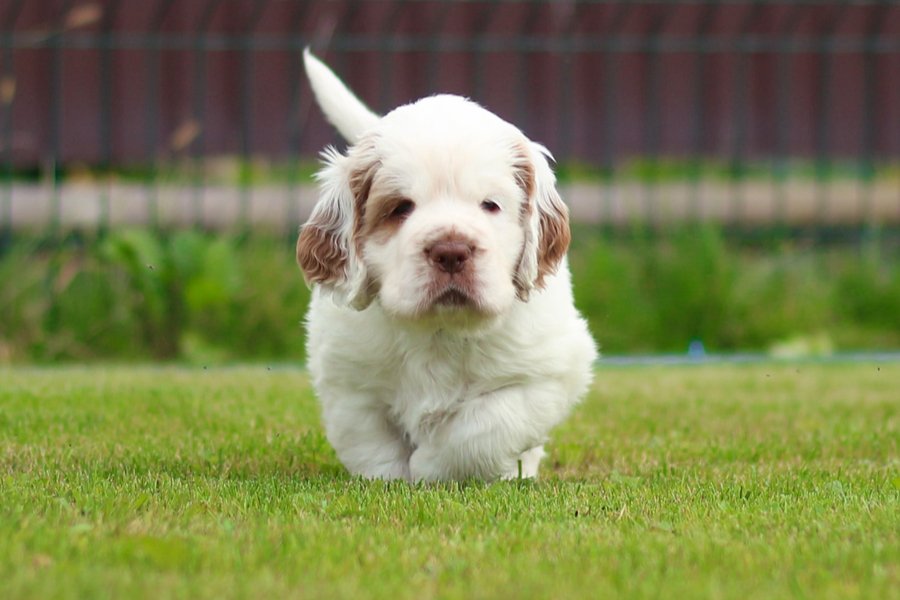

We can connect you with Breeders that are specialized in this particular breed.
See available puppies

Need some advice?
Whether you're a first time pet owner, an experienced pet owner, a new or long-time breeder, or just curious about pets, we've got you covered!

January 17, 2024
What Is The Personality Of Russian Blue Cats?
Russian Blue cats are most known for their distinctive shimmery blue-silver coat and piercing green eyes. However, this breed’s calm and gentle temperament is what makes them shine the most in the feline world.

January 17, 2024
10 Facts About Russian Blue Cat Breed
Russian Blues are one of the most aesthetically stunning cat breeds, with a gorgeous plush silvery coat and vibrant green eyes. However, it’s not only their appearance that is beautiful; their nature is too.

January 17, 2024
How To Choose The Right Cat Breed for You
Cats can make the most fantastic animal companions; they are adorable, friendly, and loving. However, not all felines are created equal. There are many different breeds, of which each has its unique personality traits.
Need some help?
Contact us to speak to our friendly advisor, who will gladly help you find your dream pet!



We are registered in England and Wales under registration number 12568840,
and our registered office is at 58-60 Kensington Church Street, W8 4DB London, England.
© 2023 The Pedigree Paws